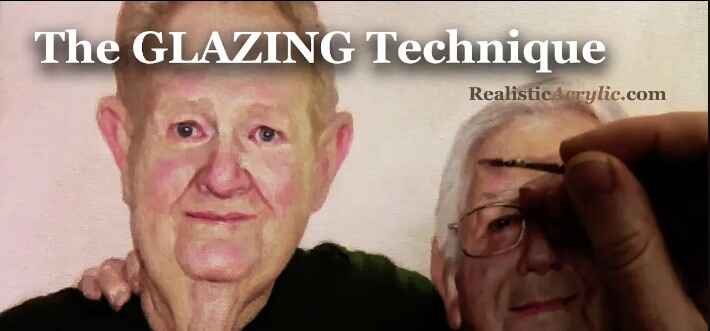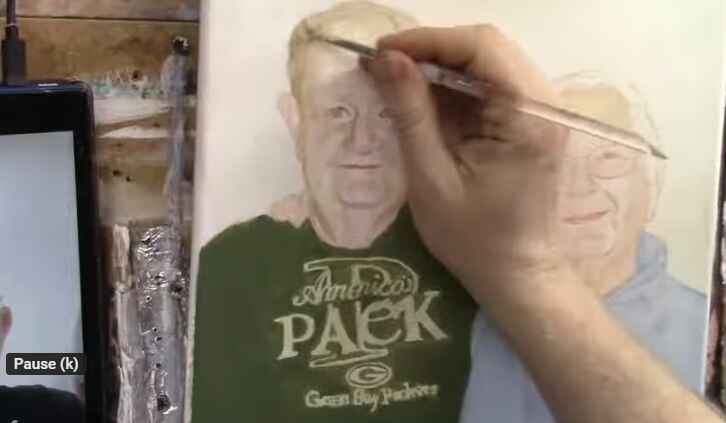- You are here:
- Home »
- Blog »
- Video Tutorial »
- How to Paint 2 Older Men using Glazing Technique

How to Paint 2 Older Men using Glazing Technique
Learn the art of painting older portraits with acrylic glazing to achieve realistic depth and detail.
Painting older portraits can be a challenging yet rewarding experience, especially when using the glazing technique with acrylics. In this tutorial, we’ll walk through the process of how to paint 2 older men using the glazing technique, and methods used to bring out realistic textures, skin tones, and details that capture the essence of age. Whether you’re working on a commission or personal project, glazing will help you layer colors and add depth, making your subjects come alive on the canvas.
What is the Acrylic Glazing Technique?
The glazing technique involves applying thin, transparent layers of paint over a dry base layer. By building up multiple layers, you create subtle transitions in color and value, giving the painting a sense of depth. This method is particularly effective for portraits, where capturing the delicate variations in skin tone is crucial. For painting older subjects, glazing is ideal as it allows you to show wrinkles, sagging skin, and the translucent quality of aging skin.

Step 1: Blocking in the Colors
When beginning a portrait with glazing, the first step is to block in the colors of the clothing. For this project, the artist started with ultramarine blue, Indian yellow, and raw sienna. These colors were used to paint the clothing of one of the men, applying them with a large flat brush. The brother’s clothing was done primarily in ultramarine blue, mixed with a bit of phthalo blue for added richness. A mixture of 75% ultramarine blue and 25% phthalo blue was used along with matte medium to maintain transparency.
Tip: Matte medium is essential when working with glazes. It helps thin the paint without losing its adhesive qualities, making it easier to apply smooth, translucent layers.
Step 2: Establishing the First Glaze
Glazing begins by applying the first transparent layer over the sketch. In this case, the clothing was built up in layers. Initially, I applied a very thin layer of paint that allowed the underlying sketch to remain visible. As the layers built up, the paint became more opaque in certain areas, particularly around the logo on one of the men’s sweaters.
Step 3: Painting the Skin Tones
Capturing realistic skin tones, especially for older subjects, requires a careful balance of warm and cool colors. I used a combination of naphthol red, raw sienna, and alizarine crimson to achieve the warm reddish tones in the face. Cooler areas were painted with raw umber dark and raw sienna.
The glazing process involved alternating between these colors to create subtle differences in the skin. Older skin has a unique texture and variation in color that requires careful attention. Areas like the cheeks and chin often appear more reddish, while the forehead and other parts may have a brownish tint.
Tip: Skin tones for older people are less uniform than younger individuals. Look for variations in color such as pinkish areas where blood vessels are closer to the surface and use glazes to subtly bring these out.
Step 4: Layering for Realism
One of the key benefits of the glazing technique is the ability to work on multiple areas of the painting simultaneously. I worked on both the faces and clothing at the same time, applying glazes of raw umber dark and titanium white to add highlights and shadows. For the glasses on one of the men, darker areas were emphasized, and the rims were highlighted using titanium white mixed with a bit of raw sienna.
In the case of the eyes, darker shadows were painted in using ultramarine blue, phthalo blue, and raw umber dark. This combination helped create depth while avoiding an overly intense blue in the iris.
Tip: When painting the eyes, adding a hint of red around the eyelids can give them a more realistic, lively appearance. The blood vessels in this area are more visible, especially in older people.
Step 5: Focus on Wrinkles and Texture
As you progress in the portrait, focusing on wrinkles and skin texture becomes vital, especially when depicting older subjects. The artist used a detail brush to carefully paint the wrinkles under the chin, as well as the fine lines in the men’s faces. Shadows were added using raw umber dark, ultramarine blue, and phthalo blue to emphasize depth, particularly under the chin and on the sides of the face.
Tip: A small detail brush is invaluable when painting wrinkles and fine textures. Larger brushes may cover too much area, while a fine-tipped brush allows for precise control.
Step 6: Final Touches and Adjustments
Towards the end of the process, the artist returned to certain areas to add more contrast and enhance details. The hair was given additional glazes to blend it seamlessly into the skin, making it appear as though it is gradually growing out of the head. Highlights were added to the forehead and around the glasses using titanium white.
For the finishing touches on the clothing, I painted the green bay packers logo on one of the men’s sweatshirts, using titanium white for the lettering and glazing over it with Indian yellow to create a rich, transparent glow.
Tip: When painting lettering or logos on clothing, use the negative space technique painting around the letters first. This makes it easier to maintain the correct proportions and alignment.
Why Glazing is Perfect for Older Portraits
The glazing technique is particularly effective for painting older subjects because it allows for gradual build-up of details. As people age, their skin becomes more translucent, with a greater contrast between warm and cool areas. Glazing helps replicate these subtleties by letting the underlying layers of paint show through, creating a more lifelike and dynamic result.
Tip: Don’t rush the glazing process. Allow each layer to dry before applying the next, and experiment with different color combinations to bring out the most natural skin tones.
Conclusion
Painting two older men using the glazing technique requires patience and attention to detail, but the results can be stunning. By carefully layering thin glazes of paint, you can create realistic skin tones, textures, and depth that bring your portraits to life. Whether you’re a seasoned portrait artist or just starting out, incorporating glazing into your acrylic painting process will help you achieve professional-quality results.
For more tips and step-by-step tutorials on how to master acrylic portrait painting, visit Realistic Acrylic Portrait School, where you can explore a range of resources, classes, and check out my free courses to enhance your acrylic painting journey.
LEARN MORE
- Sketching Your Painting Accurately
- Beginning a Pet Portrait in Acrylic
- The Mystery of Realism in Painting
- Apply A Burnt Sienna Glaze to a Portrait
- Learn How to Sketch a Portrait Freehand in 45 Minutes
- Adding highlights to your acrylic painting
- 5 Excellent Reasons to Use Aluminum Foil
- Paint Realistic Wrinkles in Acrylic
- Painting Clothing in an Acrylic Portrait
- Paint a Cloudy Sky Acrylic
- How to add Semi-Opaque Highlights
- How to Enhance the Contrast in Your Acrylic
- How to Add Glaze to Your Acrylic Painting
- Paint Realistic Reflections on Eyeglasses in an Acrylic Portrait
- Build Up Depth on Your Acrylic Portrait Backgrounds
- How Do You Do Layers With the Glazing Technique?
- Learn How to Paint Wrinkles in Acrylic
Read more about how to paint a portrait that you can surely be proud of!
I’d love to hear your thoughts on this video. Please share it with your friends and family. Let me know if you have any further questions. I’ll greatly help you.
If you’d like to learn more, sign up for my free email tips and video class today.
Learn How to Paint Acrylic Portraits With My Free Mini-Video Course!Thank you so much for taking the time to read this tutorial and watch the video. That means a lot to me. I hope you find it very helpful in your portrait painting.
Yours for Better Portraits,
P.S. Did you find this post helpful or encouraging? If so, send it in ahead! Let others know with the share buttons below. I’d love to hear your comments. Thank you so much! Also, do you have a question on acrylic portrait painting you’d like answered? Let me know, and I’d be happy to help!
